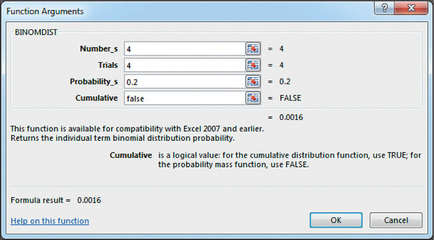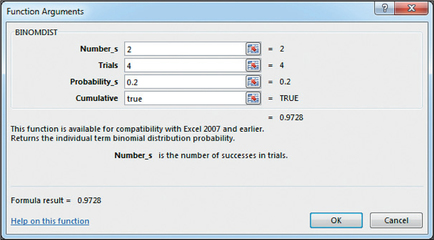STEP-BY-STEP TECHNOLOGY GUIDE: Finding Binomial Probabilities
For Example 18 (page 333):
TI-83/84
- Step 1 Press 2nd > DISTR (the VARS key).
- Step 2 Do one of (a) or (b):
- For individual binomial probabilities, highlight binompdf(, and press ENTER.
- For cumulative binomial probabilities, highlight binomcdf(, and press ENTER.
- Step 3 Enter the values for n, p, and K, separated by commas.
- Step 4 Press ENTER. (See Figures 9 and 10 on page 333.)
EXCEL
- Step 1 Select cell A1. Click the Insert Function icon fx.
- Step 2 In the Search for a function area, type BINOMDIST, click Go then OK.
- Step 3 For Number_s, enter the number of successes, K. For Trials, enter the sample size, n. For Probability_s, enter the probability of success, p.
- Step 4 Do one of (a) or (b):
- a. For individual binomial probabilities, next to Cumulative, enter false.
- b. For cumulative binomial probabilities, next to Cumulative, enter true.
- Step 5 Click OK. See Figures 16 and 17 for illustrations using Example 18.
 FIGURE 16 Example 18(a) using Excel.
FIGURE 16 Example 18(a) using Excel. FIGURE 17 Example 18(b) using Excel.
FIGURE 17 Example 18(b) using Excel.
Page 337
MINITAB
- Step 1 Click Calc > Probability Distributions > Binomial…
- Step 2 Do one of (a) or (b):
- For individual binomial probabilities, select Probability and enter the number of trials n and probability of success p.
- For cumulative binomial probabilities, select Cumulative Probability and enter the number of trials n and probability of success p.
- Step 3 Select Input Constant, enter K and click OK.
SPSS
- Step 1 Input any one number into the first element of the spreadsheet. Rename the variable Prob.
- Step 2 Select Transform > Compute Variable…. In Target Variable, type Prob.
- Step 3 Do one of (a) or (b):
- For individual binomial probabilities, under Function group select PDF & Noncentral PDF. Under Functions and Special Variables, double-click Pdf.Binom. Replace the three question marks with the number of successes K, the number of trials n, and the probability of success p, in that order.
- For cumulative binomial probabilities, under Function group select CDF & Noncentral CDF. Under Functions and Special Variables, double-click Cdf.Binom. Replace the three question marks with the number of successes K, the number of trials n, and the probability of success p, in that order.
- Step 3 Click OK and OK. Minimize the output window.
JMP
- Step 1File > New > Data Table. Double-click the first element of Column 1. Right-click the header of Column 1. Select Column Info… and under Column Properties, choose Formula. Click Edit Formula.
- Step 2 Click Discrete Probability under Functions (grouped).Step 3 Do one of (a) or (b):
- For individual binomial probabilities, select Binomial Probability. Input probability of success p, number of trials n, and number of successes K, in that order.
- For cumulative binomial probabilities, select Binomial Distribution. Input probability of success p, number of trials n, and number of successes K, in that order.
- Step 3 Click OK twice.
CRUNCHIT!
- Step 1 Click Distribution calculator > Binomial.
- Step 2 For n, enter 4. For p, enter 0.2.
- Step 3 Do one of (a) or (b):
- For individual binomial probabilities, select = from the drop-down menu next to P(X, and enter 4 in the box beside it. Click Calculate. See Figure 12 for the result.
- For cumulative binomial probabilities, select ≤ from the drop-down menu, and enter 2. Click Calculate. See Figure 13 for the result.
[Leave] [Close]